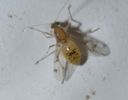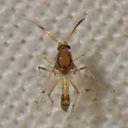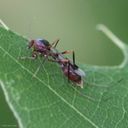Ceratopogoninae
Ceratopogoninae
Classification
- Phylum: Arthropoda
- Subphylum: Hexapoda
- Class: Insecta
- Order: Diptera
- Infraorder: Culicomorpha
- Family: Ceratopogonidae
- Subfamily: Ceratopogoninae
Pronunciation
How to pronounce Ceratopogoninae: /ˌsɛrətoʊˌpoʊˈdʒɪni.aɪ/
These audio files are automatically generated. While they are not always 100% accurate, they are a good starting point.
Images






Summary
Ceratopogoninae is the largest subfamily of Ceratopogonidae, commonly known as biting midges or no-see-ums, and includes many species that prey on other insects and feed on vertebrate blood.
Physical Characteristics
Generally 1–3 millimeters (1⁄16–1⁄8 in) in length. Mouthparts are well-developed for cutting the skin of their hosts.
Identification Tips
Tribes Culicoidini and Ceratopogonini have media petiolate, i.e., forking after R-M crossvein, or have base of M2 absent while other tribes have media sessile, forking before crossvein, and have base of M2 present.
Habitat
Streams, lakes, ponds, sphagnum bogs.
Distribution
More than 5,000 species worldwide, excluding Antarctica and the Arctic.
Diet
Adult males and females feed on nectar; most females also feed on the blood of vertebrates for egg-laying. Some species prey on other insects, such as mosquito larvae.
Life Cycle
Holometabolous; includes four life stages: egg, larva, pupa, and adult. Most common species in warmer climates take about two to six weeks to complete a life cycle.
Reproduction
Females of many genera are hematophagous and require blood to produce eggs; males generally do not feed on blood.
Predators
Some species within the biting midges prey on other small insects, particularly mosquito larvae.
Ecosystem Role
Females are parasites and can be vectors of disease-causing pathogens; some species play a role in controlling insect populations.
Economic Impact
Can transmit diseases affecting livestock and humans; economically significant due to their biting behavior and disease vector potential.
Health Concerns
Can be vectors of diseases such as bluetongue disease, African horse sickness, epizootic hemorrhagic disease, and various parasitic nematodes.
Collecting Methods
- Luring with carbon dioxide traps
- Light traps
Preservation Methods
- Ethanol
- Drying
Evolution
The oldest known member is Archiaustroconops besti from the Purbeck Group of Dorset, England, dating to around 142 million years ago.
Similar Taxa
- Ceratopogonidae
- Forcipomyiinae
- Leptoconopinae
- Dasyheleinae
Misconceptions
Often mistaken for mosquitoes; smaller and less harmful than many realize.
Tags
- Ceratopogoninae
- biting midges
- no-see-ums
- Diptera
- holometabolous